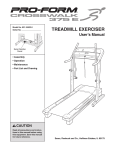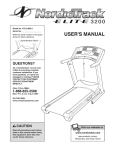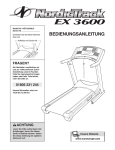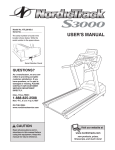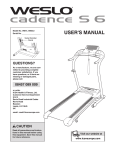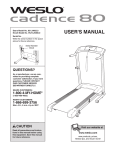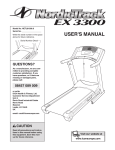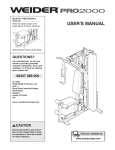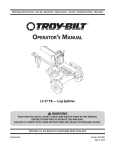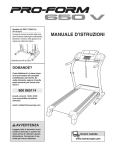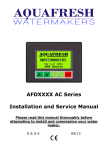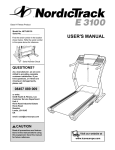Download USER`S MANUAL
Transcript
Model No. NETL82406.0 Serial No. Write the serial number in the space above for future reference. Serial Number Decal QUESTIONS? As a manufacturer, we are committed to providing complete customer satisfaction. If you have questions, or if there are missing or damaged parts, please call: 08457 089 009 or write: ICON Health & Fitness, Ltd. Customer Service Department Unit 4 Revie Road Industrial Estate Revie Road Beeston Leeds, LS118JG UK email: [email protected] CAUTION Read all precautions and instructions in this manual before using this equipment. Save this manual for future reference. USER'S MANUAL TABLE OF CONTENTS IMPORTANT PRECAUTIONS . . . . . . . . . . . . . . . . . . . . . . . . . . . . . . . . . . . . . . . . . . . . . . . . . . . . . . . . . . . . . . . . .3 BEFORE YOU BEGIN . . . . . . . . . . . . . . . . . . . . . . . . . . . . . . . . . . . . . . . . . . . . . . . . . . . . . . . . . . . . . . . . . . . . . . .6 ASSEMBLY . . . . . . . . . . . . . . . . . . . . . . . . . . . . . . . . . . . . . . . . . . . . . . . . . . . . . . . . . . . . . . . . . . . . . . . . . . . . . . .7 HOW TO USE THE CHEST PULSE SENSOR . . . . . . . . . . . . . . . . . . . . . . . . . . . . . . . . . . . . . . . . . . . . . . . . . . .12 OPERATION AND ADJUSTMENT . . . . . . . . . . . . . . . . . . . . . . . . . . . . . . . . . . . . . . . . . . . . . . . . . . . . . . . . . . . .13 HOW TO FOLD AND MOVE THE TREADMILL . . . . . . . . . . . . . . . . . . . . . . . . . . . . . . . . . . . . . . . . . . . . . . . . . .28 TROUBLESHOOTING . . . . . . . . . . . . . . . . . . . . . . . . . . . . . . . . . . . . . . . . . . . . . . . . . . . . . . . . . . . . . . . . . . . . . .30 EXERCISE GUIDELINES . . . . . . . . . . . . . . . . . . . . . . . . . . . . . . . . . . . . . . . . . . . . . . . . . . . . . . . . . . . . . . . . . . .33 PART LIST . . . . . . . . . . . . . . . . . . . . . . . . . . . . . . . . . . . . . . . . . . . . . . . . . . . . . . . . . . . . . . . . . . . . . . . . . . . . . . .34 HOW TO ORDER REPLACEMENT PARTS . . . . . . . . . . . . . . . . . . . . . . . . . . . . . . . . . . . . . . . . . . . . . .Back Cover Note: An EXPLODED DRAWING is attached in the center of this manual. NordicTrack is a registered trademark of ICON IP, Inc. 2 IMPORTANT PRECAUTIONS WARNING: To reduce the risk of burns, fire, electric shock, or injury to persons, read the following important precautions and information before operating the treadmill. 1. It is the responsibility of the owner to ensure that all users of this treadmill are adequately informed of all warnings and precautions. 12. Never move the walking belt whilst the power is turned off. Do not operate the treadmill if the power cord or plug is damaged, or if the treadmill is not working properly. (See BEFORE YOU BEGIN on page 6 if the treadmill is not working properly.) 2. Use the treadmill only as described. 3. Place the treadmill on a level surface, with at least 2.5 m (8 ft) of clearance behind it and 0.5 m (2 ft) on each side. Do not place the treadmill on a surface that blocks any air openings. To protect the floor or carpet from damage, place a mat under the treadmill. 13. Read, understand, and test the emergency stop procedure before using the treadmill (see HOW TO TURN ON THE POWER on page 15). 14. Never start the treadmill whilst you are standing on the walking belt. Always hold the handrails whilst using the treadmill. 4. Keep the treadmill indoors, away from moisture and dust. Do not put the treadmill in a garage or covered patio, or near water. 15. The treadmill is capable of high speeds. Adjust the speed in small increments to avoid sudden jumps in speed. 5. Do not operate the treadmill where aerosol products are used or where oxygen is being administered. 16. The pulse sensors are not medical devices. Various factors, including the user's movement, may affect the accuracy of heart rate readings. The pulse sensors are intended only as exercise aids in determining heart rate trends in general. 6. Keep children under the age of 12 and pets away from the treadmill at all times. 7. The treadmill should not be used by persons weighing more than 158 kg (350 lbs). 17. Never leave the treadmill unattended while it is running. Always remove the key, unplug the power cord and move the on/off switch to the off position when the treadmill is not in use. (See the drawing on page 5 for the location of the on/off switch.) 8. Never allow more than one person on the treadmill at a time. 9. Wear appropriate exercise clothes when using the treadmill. Do not wear loose clothes that could become caught in the treadmill. Athletic support clothes are recommended for both men and women. Always wear athletic shoes. Never use the treadmill with bare feet, wearing only stockings, or in sandals. 18. Do not attempt to raise, lower, or move the treadmill until it is properly assembled. (See ASSEMBLY on page 6, and HOW TO FOLD AND MOVE THE TREADMILL on page 28.) You must be able to safely lift 20 kg (45 lbs) in order to raise, lower, or move the treadmill. 10. When connecting the power cord (see page 11), plug the power cord into an earthed circuit. No other appliance should be on the same circuit. When replacing the fuse, an ASTA approved BS1362 type should be fitted to the fuse carrier. A 13 amp fuse should be used. 19. Do not change the incline of the treadmill by placing objects under the treadmill. 20. When folding or moving the treadmill, make sure that the storage latch is fully closed. 11. Keep the power cord away from heated surfaces. 3 connection to grounding electrodes, and requirements for the grounding electrode. 21. When using iFIT cards, an tone will alert you when the speed and/or incline of the treadmill is about to change. Always listen for the tone and be prepared for speed and/or incline changes. In some instances, the speed and/or incline may change before the personal trainer describes the change. 29. An outside antenna system should not be located in the vicinity of overhead power lines or other electric light or power circuits, or where it can fall into such power lines or circuits. When installing an outside antenna system, extreme care should be taken to keep from touching such power lines or circuits, as contact with them might be fatal. 22. When using iFIT cards, you can manually override the speed and incline settings at any time by pressing the speed and incline buttons. However, when the next tone is heard, the speed and/or incline will change to the next settings of the program. 30. To reduce the risk of electric shock, do not remove the cover or the back of the television. There are no user serviceable parts inside. Refer servicing to qualified service personnel. 23. Always remove iFIT cards from the iFIT slot when you are not using them. 31. Upon completion of any service or repairs to the treadmill or the television, ask the service technician to perform safety checks to confirm that the unit is in proper operating condition. 24. Inspect and properly tighten all parts of the treadmill every three months. 25. Never drop or insert any object into any opening. 26. • Use No. 10 AWG (5.3mm2) copper, No. 8 AWG (8.4mm2) aluminum, No. 17 AWG (1.0mm2) copper-clad steel or bronze wire, or larger as a ground wire. DANGER: Always unplug the power cord immediately after use, before cleaning the treadmill, and before performing the maintenance and adjustment procedures described in this manual. Never remove the motor hood unless instructed to do so by an authorized service representative. Servicing other than the procedures in this manual should be performed by an authorized service representative only. • Secure an antenna lead-in and ground wires to the house with stand-off insulators spaced from 4 to 6 feet (1.22 to 1.83m) apart. • Mount an antenna discharge unit as close as possible to where the lead-in enters the house. 27. The treadmill is intended for in-home use only. Do not use the treadmill in any commercial, rental, or institutional setting. • Use a jumper wire not smaller than No. 6 AWG (13.3mm2) copper, or the equivalent when a separate antenna-grounding electrode is used. See Local Codes. 28. If an outside antenna or cable system is connected, be sure that the antenna or cable system is grounded to provide some protection against voltage surges and built-up static charges. Section 810 of the National Electrical Code, ANSI/NFPA No. 70-1984, provides information with respect to proper grounding of the mast and supporting structure, grounding of the lead-in wire to an antenna discharge unit, size of grounding conductors, location of antenna discharge unit, Note to CATV system installer: See Local Codes for grounding requirements. 4 Power Lines Ground Clamp Service Entrance Conductors Standoff Insulators Mast To External Antenna Terminal of Treadmill Service Entrance Equipment Power Service Grounding Electrode System (e.g. Interior Metal Water Pipe) Antenna Lead-in Wire Ground Wire Antenna Discharge Unit Ground Wire Ground Clamps Bonding Jumper Ground Clamps Optional Antenna Grounding Electrode Driven 8 Feet (2.44m) Into The Earth (If Required By Local Codes). WARNING: Before beginning this or any exercise program, consult your physician. This is especially important for persons over the age of 35 or persons with pre-existing health problems. Read all instructions before using. ICON assumes no responsibility for personal injury or property damage sustained by or through the use of this product. SAVE THESE INSTRUCTIONS The decals shown have been placed on your treadmill. If a decal is missing, or if it is not legible, please call our Customer Service Department to order a free replacement decal (see the back cover of this manual). Apply the decal in the location shown. 5 50% BEFORE YOU BEGIN Thank you for selecting the revolutionary NordicTrack® EX 3600 treadmill. The EX 3600 treadmill offers an impressive selection of features designed to make your workouts at home more enjoyable and effective. And when you’re not exercising, the unique EX 3600 treadmill can be folded up, requiring less than half the floor space of other treadmills. see the front cover of this manual. To help us assist you, please note the product model number and serial number before calling. The model number of the treadmill is NETL82406.0. The serial number can be found on a decal attached to the treadmill (see the front cover of this manual for the location). Before reading further, please familiarize yourself with the parts that are labeled in the drawing below. For your benefit, read this manual carefully before using the treadmill. If you have additional questions, Television Accessory Tray Console Handrail Key/Clip Latch Knob Handgrip Pulse Sensor Walking Belt Antenna Terminal On/Off Switch Circuit Breaker Foot Rail BACK Adjustable Cushioned Walking Platform RIGHT SIDE Rear Roller Adjustment Bolts 6 76)–4 t (77)–2 1” Tek Screw (82)–4 ASSEMBLY 1/2” Screw (10)–3 3/4” Tek Screw (58)–8 Assembly requires two persons. Set the treadmill in a cleared area and remove all packing materials. Do not dispose of the packing materials until assembly is completed. Note: The underside of the treadmill walking belt is coated with high-performance lubricant. During shipping, a small amount of lubricant may be transferred to the top of the walking belt or the shipping carton. This is a normal condition and does not affect treadmill performance. If there is lubricant on top of the walking belt, simply wipe off the lubricant with a soft cloth and a mild, non-abrasive cleaner. Assembly requires the included hex key and your own phillips screwdriver . For help identifying assembly hardware, see the drawings below. Note: If a part is not found in the part bags, check to see if the part has been preattached. To avoid damaging plastic parts, do not use power tools for assembly. Upright Star Washer (71)–6 Handrail Bolt (64)–6 Handrail Star Washer (90)–6 3/4” Screw (4)–2 Upright Bolt (72)–6 Washer (78)–6 1. Identify the Right Upright (74), which is marked with a sticker. Place the Right Upright near the right side of the treadmill. Next, identify the lower end of the Right Upright, which has three small holes. Feed the Upright Wire (75) into the lower end of the Right Upright and out of the upper end as shown. 1 See the inset drawing. Place the Left Upright (73) near the left side of the treadmill. Feed the TV Cable (110) into the lower end of the Left Upright and out of the upper end as shown. Stretch the included elastic bands around the upper ends of the Uprights (73, 74) to hold the TV Cable (110) and the Upright Wire (75). Do not remove the elastic bands until you begin step 6. 75 Band 73 110 Band 7 74 Small Holes 2. Insert the Right Upright (74) into the indicated bracket on the Base (83); be careful not to dislodge the Cage Nuts (76 [see the inset drawing]) from the Right Upright; in addition, be careful not to pinch the Upright Wire (75). Finger tighten three Upright Bolts (72) with three Washers (78) and three Upright Star Washers (71) into the bracket and the Right Upright. Do not tighten the Upright Bolts yet. 2 73 75 74 71 78 72 78 72 Repeat this step with the Left Upright (73). 76 71 3. Attach the Catch (5) to the left side of the Frame (48) with two 3/4” Screws (4). 3 Left side of Treadmill With the help of a second person, raise the Frame (48) to a vertical position. Be careful not to raise the Frame past the vertical position. Have the other person hold the Frame until step 5 is completed. 5 4 4. Hold the cylinder end of the Gas Spring (88) near the bracket in the center of the Frame (48). 4 Cylinder See the two small inset drawings. Using your fingernail or the end of a screwdriver, press on the end of the Spring Pin (102) to loosen it from the Gas Spring (88). Next, rotate the Spring Pin and pull it out of the Shock. Be careful to avoid losing the Spring Pin. Orient the Gas Spring (88) so it is in the position shown. Press the end of the Gas Spring onto the ball on the bracket. See drawing 4a. Insert the Spring Pin (102) into the two indicated small holes in the end of the Gas Spring (88). Then, rotate the Spring Pin until it clips onto the Shock. Note: Extra Spring Pins are included. 48 102 48 88 Bracket 102 102 4a 88 102 Hole Bracket Hole 8 83 Bracket 5. Remove the Spring Pin (102) from the lower end of the Gas Spring (88). 5 48 88 Next, press the lower end of the Gas Spring (88) onto the ball on the bracket on the Base (83). If necessary, pivot the Frame (48) slightly and rotate the Gas Spring to align the end of the Gas Spring with the ball on the bracket. 83 102 Bracket See drawing 5a. Insert the end of the Spring Pin (102) into two of the small holes in the end of the Gas Spring (88). Then, rotate the Spring Pin until it clips onto the Gas Spring. 5a 88 Carefully lower the Frame (48) to the floor. 102 Bracket 6. Remove the elastic bands securing the Upright Wire (75) and the TV Cable (110). Next, insert the Upright Wire and the TV Cable through the Handrail Spacers (95) as shown, and press the Handrail Spacers into the tops of the Uprights (73, 74). With the help of a second person, hold the console assembly near the Uprights (73, 74). Connect the Upright Wire (75) to the wire harness on the console assembly. Make sure to connect the connectors properly (see the inset drawing); the connectors should slide together easily and snap into place. If the connectors do not slide together easily and snap into place, turn one connector and try again. IF THE CONNECTORS ARE NOT CONNECTED PROPERLY, THE CONSOLE MAY BE DAMAGED WHEN THE POWER IS TURNED ON. 6 Cable 110 Console Assembly 95 Console Wire 75 95 73 74 Next, connect the TV Cable (110) to the cable on the left side of the console assembly. Insert the Upright Wire (75) and the TV Cable (110) down into the Uprights (73, 74). Next, insert the brackets on the console assembly into the Uprights. Be careful not to pinch the wires. 7. Finger tighten three Handrail Bolts (64), with three Handrail Star Washers (90), into the Right Upright (74) and console assembly. Repeat with the Left Upright (73). After all six Handrail Bolts have been started, tighten the four front Handrail Bolts before tightening the other two Bolts. 75 7 Console Assembly 73 64 90 64 90 9 74 8. Press the Latch Sleeve (96) into the Left Upright (73). If necessary, use a rubber mallet to fully insert the Sleeve. 8 Knob Remove the knob from the pin. Make sure that the collar and the spring are on the pin. Next, insert the pin into the Latch Sleeve (96) and the Left Upright (73), and tighten the knob back onto the pin. Collar Pin 96 Spring 73 9. Place the treadmill in the storage position (see HOW TO FOLD THE TREADMILL FOR STORAGE on page 28). Center the Frame (48) between the Uprights (73, 74). Tighten the Upright Bolts (72) in the lower ends of the Uprights (73, 74). 9 48 74 73 72 72 10. Make sure that all parts are properly tightened before you use the treadmill. Note: Extra hardware may be included. Keep the included allen wrench in a secure place; the allen wrench is used to adjust the walking belt (see page 31). To protect the floor or carpet, place a mat under the treadmill. 10 Before the personal television can be used, you must connect an antenna, a 75 ohm CATV cable, or a VCR to the 75 ohm antenna terminal on the treadmill frame. Note: No antenna, cable, or adapter is included. HOW TO CONNECT AN ANTENNA 300 Ohm Flat Wire Indoor Antenna 1. See the drawing near the bottom of this page. Connect the 300 ohm flat wire from the antenna to a 300 ohm to 75 ohm adapter. 1. Place a VHF antenna in the desired location. Connect the 300 ohm flat wire from the antenna to a 300 ohm to 75 ohm adapter. 2. Push the 300 ohm to 75 ohm adapter onto the 75 ohm antenna terminal on the treadmill frame near the power cord. Screwdriver 2. Push the 300 ohm to 75 ohm adapter onto the 75 ohm antenna terminal on the treadmill frame near the power cord. VHF 300 Ohm Flat Wire 75 Ohm CATV Cable 1. See the drawing near the bottom of this page. Connect the 75 ohm CATV cable from the antenna to the 75 ohm antenna terminal on the treadmill frame near the power cord. 300 to 75 Ohm Adapter HOW TO CONNECT A 75 OHM CATV CABLE VHF Antenna 1. Connect a 75 ohm CATV cable to the 75 ohm antenna terminal on the treadmill frame near the power cord. 300 to 75 Ohm Adapter 75 Ohm Terminal 75 Ohm CATV Cable 75 Ohm Terminal HOW TO CONNECT A VCR Outdoor Antenna 1. Connect one end of a 75 ohm CATV cable to the video output jack on your VCR. Note: Outdoor antennas are subject to weathering that can reduce signal quality. Inspect your antenna and the lead-in wiring before connecting the antenna. 2. Plug in the power cord of your VCR. See your VCR user’s manual for proper grounding instructions. 3. Connect the 75 ohm CATV cable to the 75 ohm antenna terminal on the treadmill frame near the power cord. Combination VHF/UHF Antennas 300 Ohm Flat Wire Note: To operate the television with your VCR, make sure that channel 3 or 4 is selected. HOW TO CONNECT A DVD PLAYER OR VCR DIRECTLY TO THE CONSOLE 300 to 75 Ohm Adapter 75 Ohm Terminal 75 Ohm CATV Cable Your DVD player or VCR can be plugged into the audio/video RCA jacks on the back of the console. Note: To operate the television with your DVD player or VCR, press the Power button once or twice (see HOW TO OPERATE THE PERSONAL TELEVISION on page 26). 75 Ohm CATV Cable 11 HOW TO USE THE CHEST PULSE SENSOR HOW TO PUT ON THE CHEST PULSE SENSOR each use, it may remain activated longer than necessary, draining the battery prematurely. The chest pulse sensor consists of two components: the chest strap and the sensor unit (see the drawing below). Insert the tab on one end of the chest strap into one end of the sensor unit, as shown in the inset drawing. Press the end of the sensor unit under the buckle on the chest strap. The tab should be flush with the front of the sensor unit. • Store the chest pulse sensor in a warm, dry place. Do not store the chest pulse sensor in a plastic bag or other container that may trap moisture. • Do not expose the chest pulse sensor to direct sunlight for extended periods of time; do not expose it to temperatures above 50° C (122° F) or below -10° C (14° F). • Do not excessively bend or stretch the sensor unit when using or storing the chest pulse sensor. Chest Strap Tabs • Clean the sensor unit using a damp cloth—never use alcohol, abrasives, or chemicals. The chest strap may be hand washed and air dried. Tab Sensor Unit Sensor Unit CHEST PULSE SENSOR TROUBLESHOOTING Buckle The instructions on the following pages explain how the chest pulse sensor is used with the console. If the chest pulse sensor does not function properly, try the steps below. Next, wrap the chest pulse sensor around your chest, and attach the other end of the chest strap to the sensor unit. Adjust the length of the chest strap, if necessary. The chest pulse sensor should be under your clothes, tight against your skin, and as high under the pectoral muscles or breasts as is comfortable. Make sure that the logo on the sensor unit is facing forward and is right-side-up. • Make sure that you are wearing the chest pulse sensor as described at the left. Note: If the chest pulse sensor does not function when positioned as described, move it slightly lower or higher on your chest. • Use saline solution such as saliva or contact lens solution to wet the two electrode areas on the sensor unit. If heart rate readings do not appear until you begin perspiring, re-wet the electrode areas. • As you walk or run on the treadmill, position yourself near the centre of the walking belt. For the console to display heart rate readings, the user must be within arm’s length of the console. Pull the sensor unit away from your body a few inches and locate the two electrode areas on the inner side (the electrode areas are covered by shallow ridges). Using saline solution such as saliva or contact lens solution, wet both electrode areas. Return the sensor unit to a position against your chest. • The chest pulse sensor is designed to work with people who have normal heart rhythms. Heart rate reading problems may be caused by medical conditions such as premature ventricular contractions (pvcs), tachycardia bursts, and arrhythmia. CHEST PULSE SENSOR CARE AND MAINTENANCE • The operation of the chest pulse sensor can be affected by magnetic interference caused by high power lines or other sources. If it is suspected that this is a problem, try relocating the treadmill. • Thoroughly dry the chest pulse sensor after each use. The chest pulse sensor is activated when the electrode areas are wetted and the heart rate monitor is put on; the chest pulse sensor shuts off when it is removed and the electrode areas are dried. If the chest pulse sensor is not dried after • The CR2032 battery may need to be replaced (see page 32). 12 OPERATION AND ADJUSTMENT THE PRE-LUBRICATED WALKING BELT Your treadmill features a walking belt coated with high-performance lubricant. IMPORTANT: Never apply silicone spray or other substances to the walking belt or the walking platform. Such substances will deteriorate the walking belt and cause excessive wear. HOW TO PLUG IN THE POWER CORD This product must be earthed. If it should malfunction or break down, earthing provides a path of least resistance for electric current to reduce the risk of electric shock. This product is equipped with a power cord having an equipment-earthing conductor and an earthing plug. Important: If the power cord is damaged, it must be replaced with a manufacturer-recommended power cord. 1 Socket on Treadmill See drawing 1. Plug the indicated end of the power cord into the socket on the treadmill. See drawing 2. Press the pins on the power cord into the metal clips in the adapter as shown. Close the adapter cover over the end of the power cord and tighten the screw in the adapter. Important: Make sure that the adapter cover is secure and the screw has been tightened before using the power cord. 2 Adapter Cover Screw Pins See drawing 3. Plug the power cord into an appropriate outlet that is properly installed and earthed in accordance with all local codes and ordinances. Important: The treadmill is not compatible with GFCI-equipped outlets. Adapter 3 Metal Clips FR/ Outlet DANGER: Improper connection of the equipment-earthing conductor can result in an increased risk of electric shock. Check with a qualified electrician or serviceman if you are in doubt as to whether the product is properly earthed. Do not modify the plug provided with the product—if it will not fit the outlet, have a proper outlet installed by a qualified electrician. 13 IT Key Clip FEATURES OF THE CONSOLE the treadmill while the voice of a personal trainer coaches you and motivates you through every step of your workout. One iFIT Card with three new programs The treadmill console offers an impressive array of is included. Additional iFIT Cards are available sepafeatures designed to make your workouts more effecrately. To purchase iFIT Cards at any time, go to tive and enjoyable. When the manual mode of the conwww.iFIT.com or call the telephone number on the sole is selected, the speed and incline of the treadmill front cover of this manual. iFIT Cards are also can be changed with the touch of a button. As you exavailable at select stores. ercise, the console will display continuous exercise ET29618M feedback. You can even measure your heart rate using (NTL29105.0) the handgrip pulse sensor or the chest pulse sensor. Whether you select the manual mode or a program, [29618] you can enjoy the shows of your choice on the perIn addition, the console features ten Cardio programs sonal television while you get in shape. and four Calorie programs. Each program automatically To turn on the power, follow the steps on page 15. To controls the speed and incline of the treadmill as it personalize console settings, see page 15. To use guides you through an effective workout. You can also the manual mode, see page 17. To use a Cardio proselect either of two Distance programs to train for longdistance runs. The console also offers two Pulse program, see page 19. To use a Calorie program, see page 20. To use a Distance program, see page 21. grams that control the speed and incline of the treadmill To create and use a Record program, see pages 21 to help you keep your heart rate near target heart rate and 22. To use a Pulse program, see page 23. To settings. You can even create your own Record prouse an iFIT card, see page 25. To operate the pergrams and save them for future use. sonal television, see page 26. The console also features the new iFIT SD system. The Note: If there is a sheet of clear plastic on the console, iFIT SD system enables the console to accept iFIT peel off the plastic. To prevent damage to the walking Cards containing workout programs designed to help platform, wear clean athletic shoes while using the you achieve specific fitness goals. For example, lose treadmill. The first time the treadmill is used, observe unwanted pounds with the 8-week Weight Loss prothe alignment of the walking belt, and center the walkgram, or train for a long-distance run with the ing belt if necessary (see page 31). Marathon program. iFIT programs automatically control 14 When the Users button is pressed, the words “User 1 Selected” or “User 2 Selected” will appear in the display. To identify yourself as User 1 or User 2, press the Users button once or twice. HOW TO TURN ON THE POWER 1 2 Plug in the power cord (see page 13). Next, locate the on/off switch on the treadmill frame near the power cord. Make sure that the on/off switch is in the on position. Important: To highlight options within the menu, press the Data Entry increase and decrease buttons. On Position 2 The display will show the total number of miles or kilometers that the walking belt has moved, the total number of hours that the treadmill has been used, and the total number of calories that the user has burned. Stand on the foot rails of the treadmill. Find the clip attached to the key (see the drawing on page 14), and slide the clip securely onto the waistband of your clothes. Next, insert the key into the console. After a moment, the display will light. Important: In an emergency situation, the key can be pulled from the console, causing the walking belt to slow to a stop. Test the clip by carefully taking a few steps backward; if the key is not pulled from the console, adjust the position of the clip. To reset any of the totals, first highlight the total that you want to reset and press the Enter button. Then, highlight NO or YES and press the Enter button. 3 Enter user information. Highlight the words USER WEIGHT and then press the Enter button. Next, press the Data Entry increase and decrease buttons to enter your weight. Then, press the Enter button. HOW TO PERSONALIZE CONSOLE SETTINGS The console features a users mode that allows you to designate yourself as User 1 or User 2, view your workout history, and enter user information before you begin exercising. If you want to enter a maximum target heart rate (see HOW TO USE A PULSE PROGRAM on page 23), first highlight MAX. HEART RATE and press the Enter button. Next, press the Data Entry increase and decrease buttons to enter a maximum target heart rate. Then, press the Enter button. The console also features a settings mode that allows you to select a system of measurement for the console, turn on and turn off the demo mode, enter an audio trainer setting, adjust the contrast settings of the console, and turn on and turn off the welcome screen. To exit the users mode, highlight START and then press the Enter button. 4 Follow the steps below to personalize console settings. 1 View your workout history. Select the settings mode. To select the settings mode, first remove the key from the console. Then, hold down the Stop button while reinserting the key into the console. Select the users mode. To select the users mode, press the Users button. The console can keep track of workout history and save information for two different users. 15 When the settings mode is selected, the display will show the word ENGLISH or METRIC to indicate which system of measurement is selected. To change the system of measurement, first highlight UNITS and press the Enter button. Next, press the Data Entry increase or decrease button to select the desired system of measurement. Then, press the Enter button. to purchase more iFIT Cards if INSTRUCTION is selected as your audio setting. If you select the ON setting, a personal trainer will simply guide you through your iFIT workouts. If you select OFF, you will hear no audio guidance during your workouts. To change the audio setting, first highlight AUDIO TRAINER and press the Enter button. Next, press the Data Entry increase or decrease button to select the desired audio setting. Then, press the Enter button. The contrast of the display can also be adjusted. To adjust the contrast of the display, first highlight CONTRAST and press the Enter button. Next, press the increase and decrease buttons to select a contrast setting. Then, press the Enter button. The display will also show the words DEMO MODE and the current setting: OFF, LOGO, ROAD, or PROGRAMS. The “demo mode” can be used while the treadmill is displayed in a store. While the demo mode is selected, the power cord can be plugged in, the key can be removed from the console, and the display will remain on. The console buttons will not function. To select a demo mode, highlight DEMO MODE and then press the Enter button. Next, press the Data Entry increase or decrease button to highlight OFF (to turn off the demo mode), LOGO (to display a logo), ROAD (to display an animation of a runner on a road), or PROGRAMS (to display previews of various programs). Then, press the Enter button. The console can also display a welcome message each time you insert the key into the console. Highlight WELCOME SCREEN and press the Enter button. Then, press the Data Entry increase or decrease button to select ON or OFF and press the Enter button. Note: If you press the Power button while you are in the settings mode, the TV settings mode will be selected (see HOW TO USE THE TV SETTINGS MODE on page 26). 5 You can select an audio setting if desired. When you use an iFIT Card, a personal trainer will guide you through your workouts and instruct you how When you are finished using the settings mode, remove the key. To exit the settings mode at any time, remove the key from the console. 16 5 HOW TO USE THE MANUAL MODE 1 To change the incline of the treadmill, press one of the twelve Zip-Incline buttons. Each time one of the buttons is pressed, the incline will gradually increase until it reaches the selected incline setting. Insert the key into the console. See HOW TO TURN ON THE POWER on page 15. 2 6 Personalize console settings if desired. See HOW TO PERSONALIZE CONSOLE SETTINGS on page 15. 3 Select a display mode and monitor your progress with the display and the intensity level bar. As you walk or run on the treadmill, the display can show the following workout information: Select the manual mode. Each time the key is inserted, the manual mode will be selected. If you have selected a program, press any of the program buttons repeatedly until the word MANUAL appears in the display. Note: Make sure that an iFIT card is not inserted into the iFIT slot. 4 Change the incline of the treadmill as desired. Start the walking belt and adjust the speed. To start the walking belt, press the Start button, the Speed increase button next to the Start button, or one of the twelve Zip-Speed buttons. If the Start button or the Speed increase button is pressed, the walking belt will begin to move at 2 Km/H. As you exercise, change the speed of the walking belt as desired by pressing the Speed increase and decrease buttons next to the Start button. Each time a button is pressed, the speed setting will change by 0.1 Km/H; if a button is held down, the speed setting will change in increments of 0.5 Km/H. If one of the twelve Zip-Speed buttons is pressed, the walking belt will gradually increase in speed until it reaches the selected speed setting. To stop the walking belt, press the Stop button. To restart the walking belt, press the Start button, the Speed increase button, or one of the twelve ZipSpeed buttons. 17 • The elapsed time. • The distance that you have walked or run. • The speed of the walking belt. • The incline level of the treadmill. • The approximate number of calories you have burned. • The approximate number of grams of carbs you have burned. • Your walking or running pace, in minutes per mile or minutes per kilometer. • Your heart rate. Note: Your heart rate can be displayed only while you use the handgrip pulse sensor or the chest pulse sensor. • In addition, the display can show a “workout history”—a profile that represents the speed settings that you select during your workout. At the beginning of each minute of your workout, an additional column will appear in the profile; as you increase or decrease the speed setting, the height of the column will increase or decrease. • The display can also show an animation of a runner on a road. As you increase or decrease the speed setting, the runner will speed up or slow down. To use the handgrip pulse sensor, first remove the sheets of clear plastic Contacts from the metal contacts on the handgrip pulse sensor. Next, stand on the foot rails and hold the metal contacts—avoid moving your hands. When your pulse is detected, your heart rate will appear in the display. For the most accurate heart rate reading, continue to hold the contacts for about 15 seconds. When the manual mode is selected, the console offers eight display modes. The display mode that you select will determine which workout information is shown. For example, the first display mode shows only the elapsed time and the distance that you have walked or run. Press the Display button repeatedly to select the desired display mode. Note: Regardless of which display mode you select, the speed or incline setting will appear in the display for a few seconds each time you change the setting. In addition, your heart rate will appear in the display for up to 40 seconds each time you use the handgrip pulse sensor or put on the chest pulse sensor. Note: If you select the display mode shown below, your heart rate will be shown in place of the approximate number of grams of carbs you have burned. 8 To turn on the fans at low speed, press the Fan button. To turn on the fans at medium speed, press the button a second time. To turn on the fans at high speed, press the button a third time. To select the auto fan mode, press the button a fourth time. When the auto fan mode is selected, the speed of the fans will automatically increase or decrease as the speed of the walking belt increases or decreases. To turn off the fans, press the Fan button again. Note: If the fans are on when the walking belt stops, the fans will automatically turn off after a few minutes. As you exercise, the intensity ET29618M level bar will indicate (NTL29105.0) the approximate intensity level of your exercise. [29618] For example, if eight of the indicators in the bar are lit, the bar shows that your intensity level is ideal for aerobic exercise. 9 When you are finished exercising, remove the key. Step onto the foot rails, press the Stop button, and adjust the incline of the treadmill to the lowest setting. The incline must be at the lowest setting when the treadmill is folded to the storage position or the treadmill will become damaged. Next, remove the key from the console and put it in a secure place. Intensity Level Bar To reset the console, press the Stop button, remove the key, and then reinsert the key. 7 Turn on the fans if desired. When you are finished using the treadmill, switch the on/off switch to the “off” position and unplug the power cord. Measure your heart rate if desired. Note: If you use the handgrip pulse sensor and the chest pulse sensor at the same time, the display will not show your heart rate accurately. 18 If the first or second display mode is selected, a profile of the speed settings of the program will appear in the display. A small arrow below the profile will indicate your progress. HOW TO USE A CARDIO PROGRAM 1 Insert the key into the console. See HOW TO TURN ON THE POWER on page 15. 2 Personalize console settings if desired. See HOW TO PERSONALIZE CONSOLE SETTINGS on page 15. 3 At the end of the first one-minute segment of the program, a series of tones will sound. If a different speed setting and/or incline setting is programmed for the second segment, the speed setting and/or incline setting will appear at the top of the display for a moment to alert you. The treadmill will then automatically adjust to the speed and incline settings for the second segment. Select a Cardio program. To select a Cardio program, press the Cardio button repeatedly. The program will continue in this way until the small arrow reaches the right end of the profile. The walking belt will then slow to a stop. If the third display mode is selected, the display will show an animation of a runner. When a Cardio program is selected, the display will show the name of the program, the maximum incline setting of the program, the maximum speed setting, and the number of minutes in the program. In addition, a profile of the speed settings of the program will appear in the display. Each Cardio program is divided into several oneminute segments. One speed setting and one incline setting are programmed for each segment. Note: The same speed setting and/or incline setting may be programmed for two or more consecutive segments. 4 At the end of the first one-minute segment of the program, a series of tones will sound. If a different speed setting is programmed for the second segment, the speed setting will move along the bottom of the display to alert you. If a different incline setting is programmed, the incline setting will appear at the top of the display for a moment. The treadmill will then automatically adjust to the speed and incline settings for the second segment. Press the Start button to start the program. A moment after the button is pressed, the treadmill will automatically adjust to the first speed and incline settings of the program. Hold the handrails and begin walking. 5 The program will continue in this way until the last segment ends. The walking belt will then slow to a stop. Select a display mode and monitor your progress with the display. When a Cardio program is selected, the console offers three display modes. Press the Display button repeatedly to select the desired display mode. 19 If the speed or incline setting for the current segment is too high or too low, you can override the setting by pressing the Speed or Incline buttons; however, when the next segment begins, the treadmill will automatically adjust to the speed and incline settings for the next segment. When a Calorie program is selected, the display will show the name of the program, the number of minutes in the program, the calorie goal (the number of calories to be burned during the program), the maximum incline setting of the program, and the maximum speed setting. In addition, a profile of the speed settings of the program will appear in the display. To stop the program at any time, press the Stop button. To restart the program, press the Start button. The walking belt will begin to move at 2 Km/H. When the next segment of the program begins, the treadmill will automatically adjust to the speed and incline settings for the next segment. 6 Measure your heart rate if desired. See step 7 on page 18. 7 4 A moment after the button is pressed, the treadmill will automatically adjust to the first speed and incline settings of the program. Hold the handrails and begin walking. Turn on the fans if desired. See step 8 on page 18. 8 When you are finished exercising, remove the key from the console. If the speed or incline setting for the current segment is too high or too low, you can override the setting by pressing the Speed or Incline buttons; however, when the next segment begins, the treadmill will automatically adjust to the speed and incline settings for the next segment. When the program ends, make sure that the incline of the treadmill is at the lowest setting. Next, remove the key from the console and put it in a secure place. When you are finished using the treadmill, switch the on/off switch to the “off” position and unplug the power cord. 5 The program will end when you reach your calorie goal or when the small arrow reaches the right end of the profile, whichever occurs first. The walking belt will then slow to a stop. Insert the key into the console. See HOW TO TURN ON THE POWER on page 15. 2 3 Select a display mode and follow your progress with the display. The Calorie program will function in the same way as a Cardio program (see step 5 on page 19), except that while you exercise, the display will show the number of calories still to be burned. HOW TO USE A CALORIE PROGRAM 1 Press the Start button to start the program. 6 Personalize console settings if desired. Measure your heart rate if desired. See step 7 on page 18. See HOW TO PERSONALIZE CONSOLE SETTINGS on page 15. Note: You must enter your weight (see step 3 on page 15) for the console to most accurately calculate the number of calories to be burned during your workout. 7 Select a Calorie program. 8 Turn on the fans if desired. See step 8 on page 18. To select a Calorie program, press the Calorie button one, two, three, or four times. When you are finished exercising, remove the key from the console. See step 8 at the left. 20 7 HOW TO USE A DISTANCE PROGRAM Measure your heart rate if desired. See step 7 on page 18. 1 Insert the key into the console. 8 See HOW TO TURN ON THE POWER on page 15. 2 See step 8 on page 18. Personalize console settings if desired. 9 See HOW TO PERSONALIZE CONSOLE SETTINGS on page 15. 3 Turn on the fans if desired. When you are finished exercising, remove the key from the console. See step 8 on page 20. Select a Distance program. To select a Distance program, press the Calorie button repeatedly until you reach the Distance programs. HOW TO CREATE A RECORD PROGRAM 1 Insert the key into the console. See HOW TO TURN ON THE POWER on page 15. 2 See HOW TO PERSONALIZE CONSOLE SETTINGS on page 15. When a Distance program is selected, the display will show the name of the program and the distance goal. Distance Program 1 helps you train for a 10-kilometer run and Distance Program 2 helps you train for a 26-mile marathon. 4 Personalize console settings if desired. 3 Select a Record program. To select a Record program, press the Record button once or twice. Press the start button and adjust the speed. See step 4 on page 17. 5 Change the incline of the treadmill as desired. See step 5 on page 17. 6 Select a display mode and follow your progress with the display. If the Record program has not yet been defined, the display will show a program time of three minutes. If the program time is more than three minutes, see HOW TO USE A RECORD PROGRAM on page 22. The Distance program will function in the same way as the manual mode, except that while you exercise, the display will show the distance still to be walked or run. Each Record program is divided into one-minute segments. One speed setting and one incline setting can be programmed for each segment. The program will end when you reach your distance goal. The walking belt will then slow to a stop. To stop the program at any time, press the Stop button. To restart the program, press the Start button. 4 Press the Start button to start the program. A moment after the button is pressed, the walking belt will begin to move. Hold the handrails and begin walking. 21 5 When a Record program is selected, the display will show the name of the program, the maximum incline setting of the program, and the maximum speed setting. In addition, a profile of the speed settings of the program will appear in the display. Select a display mode and program the desired speed and incline settings. When a Record program is selected, the console offers three display modes. Press the Display button repeatedly to select the desired display mode. Note: If the display shows a program time of three minutes, see HOW TO CREATE A RECORD PROGRAM on page 21. To program a speed setting and an incline setting for the first one-minute segment of the program, simply adjust the speed and incline of the treadmill as desired by pressing the Speed and Incline buttons. Each Record program is divided into one-minute segments. One speed setting and one incline setting are programmed for each segment. When the first segment ends, a series of tones will sound and the current speed setting and the current incline setting will be saved in memory. 4 A moment after the button is pressed, the treadmill will automatically adjust to the first speed and incline settings that you programmed previously. Hold the handrails and begin walking. Program a speed setting and an incline setting for the second segment as described above. Continue programming speed and incline settings for up to 30 segments. 5 When you are finished with your workout, press the Stop button twice. The Record program will then be saved in memory. 6 When you are finished exercising, remove the key from the console. If desired, you can redefine the program while using it. To change the speed or incline setting for the current segment, simply press the Speed or Incline buttons. When the current segment ends, the new setting will be saved in memory. To increase the length of the program, first wait until the program ends. Then, press the Start button and program speed and incline settings for as many additional segments as desired; Record programs can have up to 30 segments. When you have added as many segments as desired, press the Stop button twice. To decrease the length of the program, press the Stop button twice at any time before the program ends. HOW TO USE A RECORD PROGRAM Insert the key into the console. See HOW TO TURN ON THE POWER on page 15. 2 Personalize console settings if desired. 6 See HOW TO PERSONALIZE CONSOLE SETTINGS on page 15. 3 Select a display mode and monitor your progress with the display. The Record program will function in the same way as a Cardio program (see step 5 on page 19). See step 8 on page 20. 1 Press the Start button to start the program. Measure your heart rate if desired. See step 7 on page 18. Select a Record program. 7 To select a Record program, press the Record button once or twice. Turn on the fan if desired. See step 8 on page 18. 8 When you are finished exercising, remove the key from the console. See step 8 on page 20. 22 segment. Note: The same target heart rate setting may be programmed for two or more consecutive segments. HOW TO USE A PULSE PROGRAM CAUTION: If you have heart prob- 5 lems, or if you are over 60 years of age and have been inactive, do not use the Pulse programs. If you are taking medication regularly, consult your physician to find whether the medication will affect your exercise heart rate. To adjust the maximum target heart rate setting, press the Data Entry increase and decrease buttons beside the Enter button (see EXERCISE INTENSITY on page 33). To adjust the target heart rate setting quickly, hold down one of the buttons. Follow the steps below to use a Pulse program. 1 6 Put on the chest pulse sensor. 7 Insert the key into the console. See HOW TO TURN ON THE POWER on page 15. 3 Press the Start button to start the program. A moment after the button is pressed, the walking belt will begin to move. Hold the handrails and begin walking. Note: You must wear the chest pulse sensor to use a Pulse program. 2 Adjust the maximum target heart rate setting if desired. Select a display mode and monitor your progress with the display. When a Pulse program is selected, the console offers two display modes. Press the Display button to select the desired display mode. Personalize console settings if desired. See HOW TO PERSONALIZE CONSOLE SETTINGS on page 15. 4 Select a Pulse program. To select a Pulse program, press the Cardio button repeatedly until you reach the Pulse programs. Regardless of which display mode you select, a profile of the target heart rate settings of the program will appear in the display. A white line representing your heartbeat will also appear; each time a heartbeat is detected, an additional peak will appear in the line. A small arrow below the profile will indicate your progress. During each one-minute segment of the program, the console will compare your heart rate to the current target heart rate setting. If your heart rate is too far below or above the target heart rate setting, the speed of the walking belt or the incline of the treadmill will automatically change to bring your heart rate closer to the target heart rate setting. Each time the speed or incline changes, the speed setting and the incline setting will appear at the top of the display for a moment to alert you. When a Pulse program is selected, the display will show the name of the program and the maximum target heart rate setting of the program. In addition, a profile of the target heart rate settings of the program will appear in the display. The Pulse programs are each divided into oneminute segments. During the first Pulse program, the same target heart rate setting is programmed for all segments (except for the first two segments). During the second Pulse program, one target heart rate setting is programmed for each When each segment ends, a series of tones will sound. 23 If the speed or incline setting for the current segment is too high or too low, you can override the setting by pressing the Speed or Incline buttons; however, when the console compares your heart rate to the current target heart rate setting, the speed or incline of the treadmill may automatically change. button. If the second Pulse program is selected, the program will continue until the small arrow reaches the right end of the profile. The walking belt will then slow to a stop. 8 Turn on the fans if desired. See step 8 on page 18. To stop the program at any time, press the Stop button. To restart the program, press the Start button. The walking belt will begin to move at 2 Km/H. When the console compares your heart rate to the current target heart rate setting, the speed or incline of the treadmill may automatically change. 9 When you are finished exercising, remove the key from the console. See step 8 on page 20. If the first Pulse program is selected, the program will continue until you stop it by pressing the Stop 24 4 HOW TO USE AN IFIT CARD 1 A moment after the button is pressed, the treadmill will automatically adjust to the first speed and incline settings of the program. Hold the handrails and begin walking. Insert the key into the console. See HOW TO TURN ON THE POWER on page 15. 2 5 Personalize console settings if desired. See HOW TO PERSONALIZE CONSOLE SETTINGS on page 15. 3 Press the Start button to start the program. Select a display mode and monitor your progress with the display and the intensity level bar. When an iFIT program is selected, the console offers three display modes (see step 6 on page 19). Press the Display button repeatedly to select the desired display mode. If the first or second display mode is selected, a profile of the speed settings of the program will appear in the display. A small arrow below the profile will indicate your progress. Insert an iFIT Card and select a program. To use an iFIT program, insert an iFIT Card into the iFIT slot; make sure that the iFIT Card is oriented so the metal contacts are on top and are inserted into the iFIT slot. During the program, a personal trainer will guide you through the workout. You can adjust the volume by pressing the Volume buttons, or you can select an audio setting for your personal trainer (see step 4 on pages 15 and 16). iFIT Card iFIT Slot If the speed or incline setting for the current segment is too high or too low, you can override the setting by pressing the Speed or Incline buttons; however, when the next segment begins, the treadmill will automatically adjust to the speed and incline settings for the next segment. Next, select an iFIT program by pressing the Data Entry increase or decrease button repeatedly. When an iFIT program is selected, the display will show the name of the program, the maximum incline setting and the maximum speed setting of the program, and the program time. In addition, a profile of the speed settings of the program will appear in the display. To stop the program at any time, press the Stop button. To restart the program, press the Start button. The walking belt will begin to move at 2 Km/H. When the next segment of the program begins, the treadmill will automatically adjust to the speed and incline settings for the next segment. 6 Turn on the fans if desired. See step 8 on page 18. 7 Each iFIT program is divided into several oneminute segments. One speed setting and one incline setting are programmed for each segment. Note: The same speed setting and/or incline setting may be programmed for two or more consecutive segments. When you are finished exercising, remove the key from the console. See step 8 on page 20. CAUTION: Always remove iFIT Cards from the iFIT slot when you are not using them. 25 HOW TO OPERATE THE PERSONAL TELEVISION HOW TO USE THE TV SETTINGS MODE The console features a TV settings mode that allows you to adjust the settings of the television and to save channels into the television’s memory. IMPORTANT: Before operating the television, you must connect an antenna, a 75 ohm CATV cable, or a VCR to the 75 ohm antenna terminal on the treadmill, or plug a DVD Player or VCR into the audio/video RCA jacks on the back of the console. See page 11 for instructions. Follow the steps below to use the TV settings mode. 1 Follow the steps below to operate the television. 1 To select the TV settings mode, first select the settings mode by holding down the Stop button while inserting the key into the console. (The TV settings mode will be selected when you press the Power button in step 2.) Insert the key into the console. See HOW TO TURN ON THE POWER on page 15. 2 Press the Power button to select a television source. 2 Next, press the Channel buttons repeatedly until the contrast, color, sharpness, or hue level indicator appears. Adjust each setting, if desired, by pressing the Volume buttons. Press the Channel buttons to select the desired channel. 3 To select a channel, press the Channel buttons. The selected channel number will appear on the screen for a few seconds. Note: The television is equipped with a channel memorizing function that allows you to go directly from the current channel to the next channel saved in memory. Before channels can be selected in this way, they must be saved in the television’s memory. See HOW TO USE THE TV SETTINGS MODE on this page. 4 Press the Power button to adjust display settings. A few seconds after the Power button is pressed, the brightness level indicator will appear on the television screen. Press the Volume buttons repeatedly to adjust the brightness setting if desired. When the key is inserted, the television will automatically turn on. If you have plugged a DVD player or VCR into the audio/video RCA jacks on the back of the console, or if you have plugged a CD player or MP3 player into the IN jack on the side of the console, select the Input source by pressing the Power button once or twice. 3 Select the TV settings mode. Press the Power button to add or delete channels. To add or delete a channel, first press the Channel buttons until the desired channel number appears on the screen. Then, press the Volume increase button to add the channel, or the Volume decrease button to delete the channel. Continue this process until you have added all desired channels and deleted all unwanted channels. 4 Press the Volume buttons to adjust the volume. When either Volume button is pressed, the volume level indicator will appear on the screen for a few seconds. Note: When the iFIT mode is selected, the Volume buttons will control the volume of the audio of the iFIT program. Press the Power button again and select a video broadcast system for a single channel. To select a video broadcast system for a single channel, first press the Channel buttons until the desired channel number appears on the screen. Then, press the Volume buttons until the desired video broadcast system for the channel appears on the screen. To use earphones or headphones (not included), plug them into the headphone jack on the console. 26 5 HOW TO ADJUST THE CUSHIONING SYSTEM Press the Power button again and select a video broadcast system for all channels. The treadmill features a cushioning system that reduces the impact as you walk or run on the treadmill. To increase the firmness of the walking platform, step off the treadmill and slide the cushion adjusters toward the front of the treadmill. To decrease the firmness, slide the cushion adjusters toward the back of the treadmill. Note: Make sure that both adjusters are set at the same firmness level. The faster you run on the treadmill, or the more you weigh, the firmer the walking platform should be. To select a video broadcast system for all channels, press the Volume buttons until the desired video broadcast system appears on the screen. 6 When you are finished using the TV settings mode, remove the key. To exit the TV settings mode at any time (except while the television is scanning channels), remove the key from the console. Cushion Adjustor Increase Decrease Cushion Adjustor Walking Platform 27 HOW TO FOLD AND MOVE THE TREADMILL HOW TO FOLD THE TREADMILL FOR STORAGE Before folding the treadmill, adjust the incline to the lowest position. If this is not done, the treadmill may be permanently damaged. Next, unplug the power cord. CAUTION: You must be able to safely lift 45 pounds (20 kg) to raise, lower, or move the treadmill. 1. Hold the end of the treadmill near the location indicated by the arrow at the right. To decrease the possibility of injury, bend your legs and keep your back straight as you raise the frame. Raise the frame about halfway to the vertical position. 2. Move your right hand to the position shown and hold the treadmill firmly. Using your left hand, pull the latch knob to the left and hold it. Raise the frame until the catch is aligned with the latch pin. Slowly release the latch knob. Make sure that the latch pin is fully inserted into the catch. To protect the floor or carpet from damage, place a mat under the treadmill. Keep the treadmill out of direct sunlight. Do not leave the treadmill in the storage position in temperatures above 30° Celsius (85° Fahrenheit). Latch Knob Closed Latch Pin Catch HOW TO MOVE THE TREADMILL 1. Before moving the treadmill, convert the treadmill to the storage position as described above. 2. Hold the treadmill and place one foot against one of the wheels. 3. Tilt the treadmill back until it rolls on the wheels. Carefully move the treadmill to the desired location. To reduce the risk of injury, use extreme caution while moving the treadmill. Do not attempt to move the treadmill over an uneven surface. 4. Place one foot against one of the wheels, and carefully lower the treadmill until the base is in the storage position. 28 Wheel Base HOW TO LOWER THE TREADMILL FOR USE 1. Hold the upper end of the treadmill with your right hand as shown. Using your left hand, pull the latch knob to the left and hold it. Pivot the frame down until it is past the latch pin. Then, slowly release the latch knob. Latch Knob Latch Pin Catch 2. Hold the frame firmly with both hands, and lower it to the floor. To decrease the possibility of injury, bend your legs and keep your back straight. 29 Open TROUBLESHOOTING Most treadmill problems can be solved by following the steps below. Find the symptom that applies, and follow the steps listed. If further assistance is needed, please see the front cover of this manual. PROBLEM: The power does not turn on SOLUTION: a. Make sure that the power cord is plugged into a properly earthed outlet (see page 13). If an extension cord is needed, use only a 3-conductor, 1 mm2 (14-gauge) cord that is no longer than 1.5 m (5 ft.). Important: The treadmill is not compatible with GFCI-equipped outlets. b. After the power cord has been plugged in, make sure that the key is inserted into the console. c. Check the circuit breaker located on the treadmill near the power cord. If the switch protrudes as shown, the circuit breaker has tripped. To reset the circuit breaker, wait for five minutes and then press the switch back in. d. Check the on/off switch located on the treadmill near the power cord. The switch must be in the “on” position. c Tripped Reset d On Position PROBLEM: The power turns off during use SOLUTION: a. Check the circuit breaker located on the treadmill frame near the power cord (see the drawing above). If the circuit breaker has tripped, wait for five minutes and then press the switch back in. b. Make sure that the power cord is plugged in. If the power cord is plugged in, unplug it, wait for five minutes, and then plug it back in. c. Remove the key from the console. Reinsert the key into the console. d. Make sure that the on/off switch is in the “on” position (see d. above). e. If the treadmill still will not run, see the front cover of this manual. PROBLEM: The displays of the console do not function properly SOLUTION: a. Remove the key from the console and UNPLUG THE POWER CORD. Place the treadmill in the storage position (see HOW TO FOLD AND MOVE THE TREADMILL on page 28). 4 Next, remove the two indicated 3/4” Screws (4). 4 Lower the treadmill (see HOW TO LOWER THE TREADMILL FOR USE on page 29). Remove the four indicated 3/4” Screws (4), and remove the Hood (44). 4 44 30 4 Next, locate the Reed Switch (14) and the Magnet (12) on the left side of the Pulley (11). Turn the Pulley until the Magnet is aligned with the Reed Switch. Make sure that the gap between the Magnet and the Reed Switch is about about 3 mm (1/8 in.) . If necessary, loosen the indicated Screw (29), move the Reed Switch slightly, and then retighten the Screw. Reattach the hood and run the treadmill for a few minutes to check for a correct speed reading. 29 14 3mm 11 12 Top View PROBLEM: The walking belt slows when walked on SOLUTION: a. Use only a single-outlet surge suppressor that meets all of the specifications described on page 11. b. If the walking belt is overtightened, treadmill performance may decrease and the walking belt may be permanently damaged. Remove the key and UNPLUG THE POWER CORD. Using the included hex key, turn both rear roller adjustment bolts counterclockwise 1/4 of a turn. When the walking belt is properly tightened, you should be able to lift each edge of the walking belt 3 to 4 inches off the walking platform. Be careful to keep the walking belt centered. Then, plug in the power cord, insert the key, and run the treadmill for a few minutes. Repeat until the walking belt is properly tightened. b 3–4” Rear Roller Bolts c. If the walking belt still slows when walked on, please see the front cover of this manual. PROBLEM: The walking belt is off-center or slips when walked on SOLUTION: a. If the walking belt is off-center, first remove the key and UNPLUG THE POWER CORD. If the walking belt has shifted to the left, use the hex key to turn the left rear roller bolt clockwise 1/2 of a turn; if the walking belt has shifted to the right, turn the bolt counterclockwise 1/2 of a turn. Be careful not to overtighten the walking belt. Then, plug in the power cord, insert the key, and run the treadmill for a few minutes. Repeat until the walking belt is centered. b. If the walking belt slips when walked on, first remove the key and UNPLUG THE POWER CORD. Using the hex key, turn both rear roller bolts clockwise 1/4 of a turn. When the walking belt is correctly tightened, you should be able to lift each edge of the walking belt 3 to 4 inches off the walking platform. Be careful to keep the walking belt centered. Then, plug in the power cord, insert the key, and walk on the treadmill for a few minutes. Repeat until the walking belt is properly tightened. 31 a b PROBLEM: The incline of the treadmill does not change correctly SOLUTION: a. With the key in the console, press one of the Incline buttons. While the incline is changing, remove the key. After a few seconds, re-insert the key. The treadmill will automatically rise to the maximum incline level and then return to the minimum level. This will recalibrate the incline system. PROBLEM: Television reception is poor SOLUTION: a. For the television to operate properly, good reception is necessary. If you are using an antenna, make sure that it is properly connected and adjusted for optimal reception. (See HOW TO CONNECT AN ANTENNA on page 11.) b. Check for the problems listed below and follow the applicable instructions. • Ignition (black spots or horizontal streaks that appear or a picture that flutters or drifts)—Usually this is caused by interference from automobile ignition systems, neon lamps, electric drifts, or other electric appliances. Try changing the position of the treadmill or other electric appliances to correct the problem. • Ghosts—Ghosts are caused by the television signal following two paths—one is the direct path and the other is reflected from tall buildings, hills, or other objects. Change the direction or position of the antenna to improve reception. • Blue Screen—If the treadmill is located in the fringe area of a television station where the signal is weak, the picture may be of poor quality or a blue screen may appear. If the signal is weak, it may be necessary to install an external antenna to improve the picture. Note: If one of these symptoms appears when the cable from a CATV company is connected, the symptom may be caused by the local company broadcast. PROBLEM: The chest pulse sensor does not function properly SOLUTION: a. If the chest pulse sensor does not function properly, see CHEST PULSE SENSOR TROUBLESHOOTING on page 12. b. If the chest pulse sensor still does not function properly, the battery should be changed. To replace the battery, locate the battery cover on the back of the sensor unit. Insert a coin into the slot in the cover and turn the cover counterclockwise to the “open” position. Remove the cover. Remove the old battery from the sensor unit. Insert a new CR 2032 battery, making sure that the writing is on top. In addition, make sure that the rubber gasket is in place in the sensor unit. Replace the battery cover and turn it to the closed position. b Battery Cover Battery Cover Battery Rubber Gasket 32 EXERCISE GUIDELINES WARNING: Before beginning this or any exercise program, consult your physician. This is especially important for individuals over the age of 35 or individuals with preexisting health problems. The pulse sensor is not a medical device. Various factors, including the user's movement, may affect the accuracy of heart rate readings. The pulse sensor is intended only as an exercise aid in determining heart rate trends in general. The following guidelines will help you to plan your exercise program. For more detailed exercise information, obtain a reputable book or consult your physician. EXERCISE INTENSITY Whether your goal is to burn fat or to strengthen your cardiovascular system, the key to achieving the desired results is to exercise with the proper intensity. The proper intensity level can be found by using your heart rate as a guide. The chart below shows recommended heart rates for fat burning and aerobic exercise. begin to use stored fat calories for energy. If your goal is to burn fat, adjust the speed or incline of the treadmill until your heart rate is near the lowest number in your training zone. For maximum fat burning, adjust the speed or incline of the treadmill until your heart rate is near the middle number in your training zone. Aerobic Exercise If your goal is to strengthen your cardiovascular system, your exercise must be “aerobic.” Aerobic exercise is activity that requires large amounts of oxygen for prolonged periods of time. This increases the demand on the heart to pump blood to the muscles, and on the lungs to oxygenate the blood. For aerobic exercise, adjust the speed or incline of the treadmill until your heart rate is near the highest number in your training zone. WORKOUT GUIDELINES Each workout should include the following three parts: A Warm-up—Start each workout with 5 to 10 minutes of stretching and light exercise. A proper warm-up increases your body temperature, heart rate and circulation in preparation for exercise. Training Zone Exercise—After warming up, increase the intensity of your exercise until your pulse is in your training zone for 20 to 60 minutes. (During the first few weeks of your exercise program, do not keep your pulse in your training zone for longer than 20 minutes.) Breathe regularly and deeply as you exercise—never hold your breath. To find the proper heart rate for you, first find your age near the bottom of the chart (ages are rounded off to the nearest ten years). Next, find the three numbers above your age. The three numbers define your “training zone.” The lower two numbers are recommended heart rates for fat burning; the highest number is the recommended heart rate for aerobic exercise. Fat Burning To burn fat effectively, you must exercise at a relatively low intensity level for a sustained period of time. During the first few minutes of exercise, your body uses easily accessible carbohydrate calories for energy. Only after the first few minutes does your body A Cool-down—Finish each workout with 5 to 10 minutes of stretching to cool down. This will increase the flexibility of your muscles and will help prevent post-exercise problems. EXERCISE FREQUENCY To maintain or improve your condition, complete three workouts each week, with at least one day of rest between workouts. After a few months, you may complete up to five workouts each week if desired. The key to success is to make exercise a regular and enjoyable part of your everyday life. 33 PART LIST—Model No. NETL82406.0 R0706A To locate the parts listed below, see the EXPLODED DRAWING attached in the center of this manual. Key No. Qty. 1 2 3 4 5 6 7 8 9 10 11 12 13 14 15 16 17 18 19 20 21 22 23 24 25 26 27 28 29 30 31 32 33 34 35 36 37 38 39 40 41 42 43 44 45 46 47 48 49 50 2 2 2 56 1 1 2 4 2 2 1 1 4 1 2 2 2 2 2 1 1 1 1 1 1 1 1 1 4 2 1 2 4 1 1 1 1 9 1 1 3 2 1 1 4 4 1 1 16 1 Description Key No. Qty. Foot Rail Cover Foot Rail Platform Cushion 3/4” Screw Catch Walking Platform Belt Guide Belt Guide Screw Front Isolator Platform Bolt, Front Front Roller/Pulley Magnet Rear Roller Washer Reed Switch Clip Incline Rod Bushing Lift Arm Lift Pivot Bolt Hood Mount Lift Arm Spacer Reed Switch Wire Idler Wheel Nut Idler Wheel Idler Wheel Bolt Lift Motor Bolt, Bottom Idler Arm Spacer Idler Arm Idler Arm Spring Motor Belt Reed Switch Screw Lift Pivot Bolt Drive Motor Motor Bolt Electronics Bracket Nut Electronics Bracket Front Endcap Controller Incline Rod Nut Lift Motor Lift Motor Bolt, Top 1/2” Outlet Screw Cushion Adjustor Outlet Assembly Hood Hood Clip Grommet Walking Belt Frame Cushion Track Screw Transformer 51 52 53 54 55 56 57 58 59 60 61 62 63 64 65 66 67 68 69 70 71 72 73 74 75 76 77 78 79 80 81 82 83 84 85 86 87 88 89 90 91 92 93 94 95 96 97 98 99 100 34 1 4 2 1 4 2 1 1 1 1 2 2 1 6 1 1 1 1 11 1 6 6 1 1 1 6 1 6 2 2 4 4 1 1 2 2 3 1 1 6 3 2 14 2 2 1 1 1 1 1 Description Right Rear Foot Rear Wheel Rear Wheel Bolt Right Rear Endcap Bracket Washer Rear Roller Adj. Bolt Allen Wrench Left Rear Foot Left Rear Endcap Rear Roller Platform Nut Platform Bolt, Rear Hood Cover Handrail Bolt Console Base Console TV Console Static Decal Electronics Screw Access Door Upright Star Washer Upright Bolt Left Upright Right Upright Upright Wire Cage Nut Motor Plate Washer Endcap Screw Base Endcap Base Pad 1” Tek Screw Base Frame Ground Wire Wheel Bolt Wheel Caution Decal Gas Spring Key/Clip Handrail Star Washer Releaseable Tie Tie Clamp 8” Plastic Tie Handrail Endcap, Bottom Handrail Spacer Latch Sleeve Top Handrail Endcap Filter Handrail Latch Assembly Key No. Qty. 101 102 103 104 105 106 107 108 109 110 111 112 113 114 115 116 117 118 119 1 1 1 1 2 1 1 1 4 1 2 1 1 1 4 1 1 3 1 Description Latch Warning Decal Spring Pin Kit Filter Wire Idler Arm Bolt Motor Bushing Incline/Controller Wire Incline Stop Bracket Stop Bracket Spacer 7.5” Plastic Tie TV Cable TV Cable Nut Chest Pulse Sensor Chest Pulse Strap Pulse Receiver Pulse Receiver Screw Icler Wheel Washer Cable Ground Wire Console Ground Wire MP3 Wire Key No. Qty. 120 121 122 123 124 # # # # # # # # # # # 1 1 1 1 1 1 1 1 1 1 1 1 1 1 1 1 Description Power Cord Power Cord Adapter Ferrite A/V Input Jack 6” Blue Wire, M/F 6” White Wire, 2F 6” Black Wire, M/F 8” Black Wire, M/F 4” Green/Yellow Wire, F/R 4” Green/Yellow Wire, F/R w/Toroid 16” Green/Yellow Wire, F/R 4” Red Wire, M/F 6” Blue Wire, M/F Grounding Nut User’s Manual #These parts are not illustrated 35 2 57 59 38 58 13 4 52 56 49 62 4 49 101 53 61 1 3 54 4 56 5 52 53 13 4 49 60 42 4 6 49 61 38 51 62 7 104 4 49 8 23 22 25 4 9 4 1 49 47 26 4 18 10 16 3 69 11 29 77 46 50 15 30 12 20 14 29 4 19 49 17 28 116 21 38 78 27 42 49 105 4 48 10 55 2 8 32 33 69 31 4 7 9 4 4 33 34 55 55 33 36 41 121 46 15 69 29 69 98 4 18 37 38 16 35 17 19 30 43 38 40 39 110 41 44 108 111 69 117 107 24 103 4 120 106 45 4 63 124 121 To identify the parts shown on this EXPLODED DRAWING, see the PART LIST on pages 34 and 35. 4 45 4 EXPLODED DRAWING—Model No. NETL82406.0 R0706A 94 89 113 112 119 94 4 97 4 4 69 4 66 4 4 99 4 70 4 115 114 4 4 4 4 4 69 4 67 4 4 93 97 4 68 91 4 86 92 29 85 4 4 118 65 4 38 87 123 115 4 64 72 109 82 81 100 90 95 78 76 102 88 38 96 64 71 90 110 86 73 38 76 87 72 79 78 82 81 75 80 90 71 46 72 85 78 82 81 71 76 64 95 46 90 83 87 75 76 64 38 74 84 69 82 81 71 72 76 78 76 79 80 EXPLODED DRAWING—Model No. NETL82406.0 R0706A ORDERING REPLACEMENT PARTS To order replacement parts, contact the ICON Health & Fitness, Ltd. office, or write: ICON Health & Fitness, Ltd. Customer Service Department Unit 4, Revie Road Industrial Estate Revie Road Beeston Leeds, LS118JG UK Tel: 08457 089 009 Outside the UK: 0 (444) 113 387 7133 Fax: 0 (444) 113 387 7125 To help us assist you, please be prepared to give the following information: • The MODEL NUMBER OF THE PRODUCT (NETL82406.0) • The NAME OF THE PRODUCT (NordicTrack® EX 3600 treadmill) • The SERIAL NUMBER OF THE PRODUCT (see the front cover of this manual) • The KEY NUMBER AND DESCRIPTION OF THE PART(S) (see the PART LIST on pages 34 and 35 and the EXPLODED DRAWING attached in the centre of this manual) Part No. 238238 R0706A Printed in USA © 2006 ICON IP, Inc.






































